External links
- The oldest version of the Swedish Bjärköarätten Lund university.
![]()
The Bjarkey laws (Old Swedish: biærköa rætter, Old Icelandic: bjarkeyjar-rettr, Norwegian: bjarkøretten, Danish: bjærkeret, birkeret) were the laws and privileges of medieval Scandinavian merchant towns (birks).
In Norway, the Bjarkey laws concerned all the merchant towns and also every location with trade, such as fishing villages and market locations. There are two versions, an early and a late Bjarkey law, of which the early one only remains as fragments and concerned the merchant town of Nidaros. The later Bjarkey law was created primarily for the merchant town of Bergen and only the most necessary amendments were made for other merchant towns. The extant manuscripts are very much in agreement, even when they explicitly concern different merchant towns. The late law was accepted at a ting in Bergen in 1276, and is divided into nine sections of which the last one, the Farmannalög is a kind of sea law. This was the first of the revised City Laws of Magnus VI of Norway (1238-1280), known as Magnus Lagabøtes bylov , and integrated into the national Magnus Lagabøtes landslov .
In Sweden, it is the oldest law put to paper for a town, and was probably written in the late 13th century or the early 14th century, influenced by the revision of the Uppland Law. The oldest manuscript for the law is from c. 1345. The law was created for the young town Stockholm and its customs, but it was also used in Lödöse and probably in a few other towns, as well. No town was allowed to use the law without the formal permission by the Swedish king. Its use may have become more widespread if it had not been superseded by the new town law by king Magnus Eriksson (1316–1377). The term Bjarkey Laws was however used for a long time for Magnus Eriksson's law in various locations.
Some Swedish scholars have suggested that the laws are considerably older than the 13th century in Sweden. Hadorph proposed that it was created as early as 832 by king Björn at Hauge for the merchant town of Birka.
![]()

Västergötland, also known as West Gothland or the Latinized version Westrogothia in older literature, is one of the 25 traditional non-administrative provinces of Sweden, situated in the southwest of Sweden.
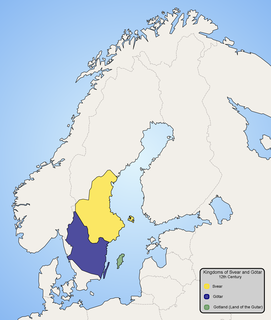
The Geats, sometimes called Goths, were a North Germanic tribe who inhabited Götaland in modern southern Sweden during the Middle Ages. They are one of the progenitor groups of modern Swedes, along with Swedes and Gutes. The name of the Geats also lives on in the Swedish provinces of Västergötland and Östergötland, the Western and Eastern lands of the Geats, and in many other toponyms.

Dalsland is a Swedish traditional province, or landskap, situated in Götaland in southern Sweden. Lying to the west of Lake Vänern, it is bordered by Värmland to the north, Västergötland to the southeast, Bohuslän to the west, and Norway to the northwest.

Magnus IV was King of Sweden from 1319 to 1364, King of Norway as Magnus VII from 1319 to 1355, and ruler of Scania from 1332 to 1360. By adversaries he has been called Magnus Smek.

Three Crowns is a national emblem of Sweden, present in the coat of arms of Sweden, and composed of three yellow or gilded coronets ordered two above and one below, placed on a blue background.

Magnus Haakonsson was King of Norway from 1263 to 1280. One of his greatest achievements was the modernisation and nationalisation of the Norwegian law-code, after which he is known as Magnus the Law-mender. He was the first Norwegian monarch known to have used an ordinal number, although originally counting himself as "IV".

Alrekstad was one of the largest Kongsgård estates on the west coast of Norway during the early Middle Ages.
Ragnvald Knaphövde was a King of Sweden whose reign is estimated to have occurred in the mid-1120s or c. 1130. His cognomen Knaphövde is explained as referring to a drinking vessel, the size of a man's head or meaning "round head" and referring to his being foolish. Ragnvald is mentioned in the regnal list of the Westrogothic law as the successor of King Inge the Younger.
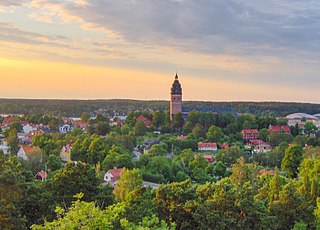
Strängnäs is a locality and the seat of Strängnäs Municipality, Södermanland County, Sweden with 12,856 inhabitants in 2010. It is located by Lake Mälaren and is the episcopal see of the Diocese of Strängnäs, one of the thirteen dioceses of the Church of Sweden. Prominently located on a hilltop, Strängnäs Cathedral, built between 1291 and 1340, is an important landmark.

The archbishop of Uppsala has been the primate in Sweden in an unbroken succession since 1164, first during the Catholic era, and from the 1530s and onward under the Lutheran church.
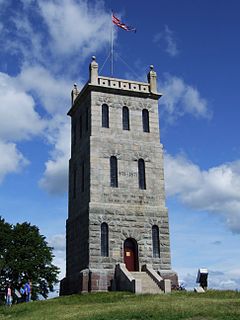
Tønsberg Fortress was a medieval fortress and castle, located in Tønsberg, Norway which was defended by the fortress for over 300 years.
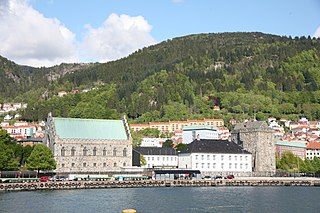
Bergenhus fortress is a fortress located in Bergen, Norway. Located at the entrance of Bergen harbour, the castle is one of the oldest and best preserved stone fortifications in Norway.
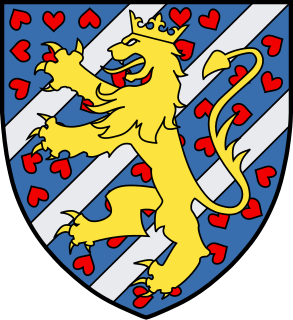
The House of Bjelbo, also known as the House of Folkung (Folkungaätten), was an Ostrogothian Swedish family that provided several medieval Swedish bishops, jarls and kings. It also provided three kings of Norway, and one king of Denmark in the 14th century.
Medieval Scandinavian law, also called North Germanic law, was a subset of Germanic law practiced by North Germanic peoples. It was originally memorized by lawspeakers, but after the end of the Viking Age they were committed to writing, mostly by Christian monks after the Christianization of Scandinavia. Initially they were geographically limited to minor jurisdictions (lögsögur), and the Bjarkey laws concerned various merchant towns, but later there were laws that applied to entire Scandinavian kingdoms. Each jurisdiction was governed by an assembly of free men, called a þing.
The Lord High Constable was a prominent and influential office in Sweden, from the 13th century until 1676, excluding periods when the office was out of use. The office holder was a member of the Swedish Privy Council and, from 1630 and on, the head of the Swedish Council of War. From 1634, the Lord High Constable was one of five Great Officers of the Realm.
The Lord High Steward or Lord High Justiciar was a highly prominent member of the Swedish Privy Council from the 13th century until 1809, excluding periods when the office was out of use.

Audun Hugleiksson (Hestakorn) was a Norwegian nobleman at the end of the 13th century. He was the king's right hand, both under King Magnus Lagabøte and King Eirik Magnusson. He was seen as an important politician and lawman in his time and played a central role in reforming the Norwegian law system.

Ås Abbey was a Cistercian monastery situated near the mouth of the River Viskan into the Kattegat in Halland, formerly part of Denmark but now in Sweden, near the present hamlet of Åskloster about 14 km north of Varberg, in Varberg Municipality.
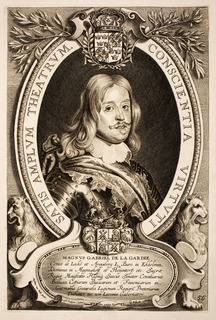
Count Magnus Gabriel De la Gardie was a Swedish statesman and military man. He became a member of the Swedish Privy Council in 1647 and came to be the holder of three of the five offices counted as the Great Officers of the Realm, namely Lord High Treasurer, Lord High Chancellor and Lord High Steward. He also served as Governor-General in the Swedish dominion of Livonia.

Magnus Lagabøtes bylov was promulgated for Bergen in 1276 during the reign of King Magnus VI of Norway. Oslo, Trondheim and Tønsberg received their own versions of the City Law about the same time, without the exact year being known for when they were adopted. The City Law was based on the State Law of Magnus Lagabøte, adopted in 1274, and the Bjarkøyretten, Trondheim's old city law, which came into force during the 1100s. Audun Hugleiksson was instrumental in the design of the law.